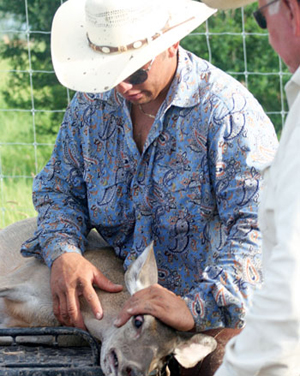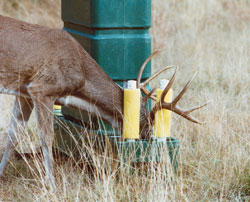
A member of the USDA Fever Tick Force inspects a tranquilized white-tailed deer.
Photo by Carla Everett – Texas Animal Health Commision
In the Texas Rio Grande Valley, known far and wide for its trophy deer, hunting is a vital part of the region’s economy. Unfortunately, white-tailed deer are secondary hosts for a tiny parasite — the cattle fever tick — that has gripped area ranches and the local cattle industry with devastating results.
Since the summer of 2007, more than 1 million acres of Texas ranchland have been placed under quarantine by the Texas Animal Health Commission (TAHC). A 500-mile-long permanent buffer zone lies along the Texas-Mexico border because, although the United States had been tick-free since 1943, Mexico has yet to eradicate the parasite.
As more and more infestations have been found outside the buffer zone in recent years, acreage has been added to the area and placed under temporary quarantine. In April 2009, the TAHC released more than 375,000 acres from temporary quarantine, but approximately 247,000 acres on 28 ranches still have temporary status.
Treating Cattle and Deer
If a tick is detected on livestock, the ranch is immediately put under quarantine, and the landowner has two options: (1) inspect and dip the livestock every 14 days for nine months, or (2) dip the animals repeatedly until they are tick-free, move them to a site outside of the quarantine area, and leave the ranch vacant for nine months.
Deer on a tick-infested ranch must be treated in the same manner. Because the deer are difficult to catch, however, many landowners follow these preventive measures:
- Feed corn treated with ivermectin pesticide (which cannot
be fed within 60 days of hunting season). - Use a “4-poster,” which is a feeder with four treated posts that
the deer must rub against to reach the feed.
Technical and financial assistance to fight the spread of the tick is available to ranchers in the affected 17 Texas counties through the USDA’s Natural Resources Conservation Services (NRCS). Local staff from the NRCS and Soil and Water Conservation Districts will help ranchers develop land management plans and provide technical assistance to help them implement practices that will fight the spread of the cattle fever tick. Wildlife upland habitat management, prescribed burning, cross-fencing and brush management are among the practices eligible for financial assistance.
Harvesting Deer Within Quarantine Zone

A "4-poster" feeder
Courtesy of USDA – ARS
For hunters and landowners alike, the good news is that deer can still be harvested on land within the quarantine zone. Just make sure that the ticks don’t ride home with the hunter.
If a deer is harvested in the quarantined area, the hunter has three options:
- • Have the hide or cape inspected and treated by the U.S. Department of Agriculture’s Fever Tick Force before removing it from the ranch.
- • Remove the hide completely and leave it on the ranch. If the skull is needed for proof of gender, it must be sealed in a bag and disposed of away from livestock or wildlife after the carcass is processed.
- • Freeze the hide for 24 hours.
According to the TAHC, fever ticks can affect the condition and general well-being of deer, but are unlikely to cause death. It is safe to eat venison from fever tick-infested deer.
While it is unlikely that hunters will bring ticks outside of the zone on either their skin or clothing, hunters are encouraged to brush off clothes and boots thoroughly before traveling outside of the zone.
Other wild game species such as Nilgai antelope; elk; Aoudad sheep; and fallow, axis and red deer also can act as hosts for cattle fever ticks.
– Staff